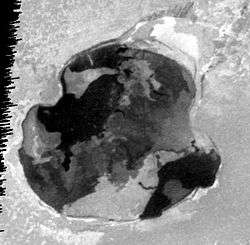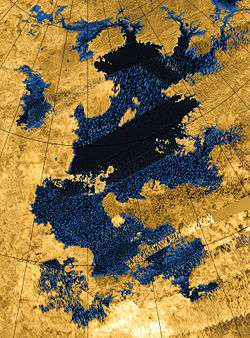List of largest lakes and seas in the Solar System
Following are the largest lakes and seas on various worlds in the Solar System. Listed are single bodies of water or other liquid on or near the surface of a solid body (terrestrial planet, planetoid, or moon). All objects in this list are expected to be round, hence anything that is part of a belt or disc is expected to be a dwarf planet.
Cold surface oceans or lakes are found on two worlds, Earth and Saturn's moon Titan. Lava lakes are found on Earth and Jupiter's moon Io. Subsurface oceans or seas occur on the other Galilean moons of Jupiter, Saturn's moons Titan and Enceladus, and are suspected on the some of Saturn's other moons, the asteroid Ceres, the larger trans-Neptunian objects, and ice planets in planetary systems. Recent analysis of the interior of Ganymede, taking into account the effects of salt, suggests that it and some of the other icy bodies may not have a single interior global ocean but several stacked ones, separated by different phases of ice, with the lowest liquid layer adjacent to the rocky mantle below.[1][2]
List
| Body | Type of object | Lake/sea | Composition | Location | Area (km2) | Average depth (km) | Notes | |
|---|---|---|---|---|---|---|---|---|
| Earth | planet (terrestrial) |
Ocean Sea | salt water | surface | 361,300,000 | 3.68 (max 11.02) |  |
71% of Earth's surface |
| Caspian Sea | salt water | surface | 371,000 | 0.21 (max 1.02) |  |
smallest ocean (geologically) (0.07% of Earth's surface) | ||
| Lake Huron–Michigan | fresh water | surface | 117,400 | 0.07 (max 0.28) | .png) |
largest lake today (geologically) | ||
| West Siberian Glacial Lake | fresh water | surface | c. 880,000 (50–60 ka) |
0.036 | glacial lakes during the Ice Age | |||
| Lake Agassiz | fresh water | surface | c. 440,000 (max) | ? | ||||
| Ceres | asteroid | (internal ocean) | water? water–ammonia mixture? |
subsurface | c. 1,000,000? | possible subsurface equatorial ocean | ||
| Io | moon of Jupiter | Gish Bar Patera | lava | surface | 9,600 | ? |  |
|
| Loki Patera | lava | surface | < 32,000 | ? | .jpg) |
|||
| Europa | moon of Jupiter | (internal global ocean) | water? water–ammonia mixture? |
subsurface | c. 30,000,000 | est. 50–100 | global ocean under 10 to 30 km of ice, perhaps twice the volume of Earth's ocean | |
| Ganymede | moon of Jupiter | (internal global ocean) | salt water? | subsurface | c. 80,000,000 apiece | 100 | 100 km thick, under 150 km of ice, six times the volume of Earth's ocean;[3] possibly three oceans, one under another | |
| Callisto | moon of Jupiter | (internal global ocean) | water? water–ammonia mixture? |
subsurface | c. 65,000,000 | 120–180 | global ocean under 135 to 150 km of ice | |
| Enceladus | moon of Saturn | (internal global ocean) | (salt?) water | subsurface | c. 650,000 | 26–31 | global ocean under 21–26 km of ice, based on libration[4] | |
| Dione | moon of Saturn | (internal global ocean) | water? water–ammonia mixture? |
subsurface | c. 1,000,000 | ? | possible global ocean under the ice | |
| Rhea | moon of Saturn | (internal global ocean) | water? water–ammonia mixture? |
subsurface | c. 1–2,000,000 | c. 15 | possible global ocean under the ice (c. 400 km)[lower-alpha 1] | |
| Titan | moon of Saturn | Kraken Mare | hydrocarbons | surface | ≈ 400,000 (0.5% of Titan's surface) |
? |  |
|
| Ligeia Mare | hydrocarbons | surface | 126,000 | (0.17 in places) | .jpg) |
|||
| (internal global ocean) | water? water–ammonia mixture? |
subsurface | c. 80,000,000 | < 300 | global ocean of water under < 100 km of ice | |||
| Titania | moon of Uranus | (internal global ocean) | water? water–ammonia mixture? |
subsurface | c. 5,000,000 | c. 15–50 | possible global ocean under the ice (c. 150–200 km) | |
| Oberon | moon of Uranus | (internal global ocean) | water? water–ammonia mixture? |
subsurface | c. 3,000,000 | c. 15–40 | possible global ocean under the ice (c. 250 km) | |
| Triton | moon of Neptune | (internal global ocean) | water? water–ammonia mixture? |
subsurface | c. 20,000,000 | c. 150–200 | possible global ocean under the ice (c. 150–200 km) | |
| Orcus | Kuiper belt object (plutino) |
(internal global ocean) | water? water–ammonia mixture? |
subsurface | c. 500,000 | c. 15 | possible global ocean under the ice (c. 200 km) | |
| Pluto | Kuiper belt object (plutino) |
(internal global ocean) | water? water–ammonia mixture? |
subsurface | c. 10–15,000,000 | c. 100–180 | possible global ocean under the ice (c. 150–230 km) | |
| Makemake | Kuiper belt object (cubewano) |
(internal global ocean) | water? water–ammonia mixture? |
subsurface | c. 3,000,000 | ? | possible global ocean under the ice | |
| 2007 OR10 | scattered disc object | (internal global ocean) | water? water–ammonia mixture? |
subsurface | c. 2–3,000,000 | ? | possible global ocean under the ice | |
| Eris | scattered disc object | (internal global ocean) | water? water–ammonia mixture? |
subsurface | c. 10,000,000 | c. 150–200 | possible global ocean under the ice (c. 150–250 km) | |
| Sedna | sednoid | (internal global ocean) | water? water–ammonia mixture? |
subsurface | c. 1,000,000 | c. 15 | possible global ocean under the ice (c. 200 km) | |
See also
- List of tallest mountains in the Solar System
- List of largest rifts and valleys in the Solar System
- List of largest craters in the Solar System
Notes
References
- ↑ Clavin, W. (2014-05-01). "Ganymede May Harbor 'Club Sandwich' of Oceans and Ice". Press release. Jet Propulsion Laboratory. Archived from the original on 2014-05-02. Retrieved 2014-05-04.
- ↑ Vance, S.; Bouffard, M.; Choukroun, M.; Sotin, C. (2014-04-12). "Ganymede's internal structure including thermodynamics of magnesium sulfate oceans in contact with ice". Planetary and Space Science. 96: 62. doi:10.1016/j.pss.2014.03.011.
- ↑ "Hubble observations suggest underground ocean on Jupiter's largest moon Ganymede". NASA press release. March 12, 2015. Retrieved 2015-10-03.
- ↑ Thomas, P. C.; Tajeddine, R.; Tiscareno, M. S.; Burns, J. A.; Joseph, J.; Loredo, T. J.; Helfenstein, P.; Porco, C. (2016). "Enceladus's measured physical libration requires a global subsurface ocean". Icarus. 264: 37. doi:10.1016/j.icarus.2015.08.037.
- ↑ Hussmann, H.; Sohl, F.; Spohn, T. (November 2006). "Subsurface oceans and deep interiors of medium-sized outer planet satellites and large trans-neptunian objects". Icarus. 185 (1): 258–273. doi:10.1016/j.icarus.2006.06.005.
- ↑ Tortora, P.; Zannoni, M.; Hemingway, D.; Nimmo, F.; Jacobson, R. A.; Iess, L.; Parisi, M. (January 2016). "Rhea gravity field and interior modeling from Cassini data analysis". Icarus. 264: 264–273. doi:10.1016/j.icarus.2015.09.022.